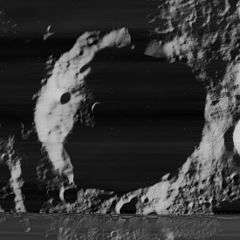Sylvester (crater)
Sylvester is a lunar impact crater that is located near the north pole of the Moon, along the northern limb in the libration zone. It lies just to the south-southeast of the craters Grignard and Hermite; the latter of which is within one crater diameter of the pole. South of Sylvester is Pascal. Due to its location, Sylvester receives sunlight at only a low angle.
 Lunar Orbiter 4 image | |
| Coordinates | 82.7°N 79.6°W |
|---|---|
| Diameter | 58 km |
| Depth | Unknown |
| Colongitude | 87° at sunrise |
| Eponym | James J. Sylvester |
This crater is generally circular, with a sharp-edged rim that has received only a moderate amount of wear. There are no craters of note along the rim, although Sylvester intrudes into a smaller, shallow-rimmed crater to the southeast. The interior floor is relatively flat, but punctuated by several tiny craters. At the midpoint is a small central peak.
Satellite craters
By convention these features are identified on lunar maps by placing the letter on the side of the crater midpoint that is closest to Sylvester.
| Sylvester | Latitude | Longitude | Diameter |
|---|---|---|---|
| N | 82.4° N | 67.3° W | 20 km |
External links
- LAC-1 area - Map of northern lunar pole
References
- Andersson, L. E.; Whitaker, E. A. (1982). NASA Catalogue of Lunar Nomenclature. NASA RP-1097.CS1 maint: ref=harv (link)
- Blue, Jennifer (July 25, 2007). "Gazetteer of Planetary Nomenclature". USGS. Retrieved 2007-08-05.CS1 maint: ref=harv (link)
- Bussey, B.; Spudis, P. (2004). The Clementine Atlas of the Moon. New York: Cambridge University Press. ISBN 978-0-521-81528-4.CS1 maint: ref=harv (link)
- Cocks, Elijah E.; Cocks, Josiah C. (1995). Who's Who on the Moon: A Biographical Dictionary of Lunar Nomenclature. Tudor Publishers. ISBN 978-0-936389-27-1.CS1 maint: ref=harv (link)
- McDowell, Jonathan (July 15, 2007). "Lunar Nomenclature". Jonathan's Space Report. Retrieved 2007-10-24.CS1 maint: ref=harv (link)
- Menzel, D. H.; Minnaert, M.; Levin, B.; Dollfus, A.; Bell, B. (1971). "Report on Lunar Nomenclature by the Working Group of Commission 17 of the IAU". Space Science Reviews. 12 (2): 136–186. Bibcode:1971SSRv...12..136M. doi:10.1007/BF00171763.CS1 maint: ref=harv (link)
- Moore, Patrick (2001). On the Moon. Sterling Publishing Co. ISBN 978-0-304-35469-6.CS1 maint: ref=harv (link)
- Price, Fred W. (1988). The Moon Observer's Handbook. Cambridge University Press. ISBN 978-0-521-33500-3.CS1 maint: ref=harv (link)
- Rükl, Antonín (1990). Atlas of the Moon. Kalmbach Books. ISBN 978-0-913135-17-4.CS1 maint: ref=harv (link)
- Webb, Rev. T. W. (1962). Celestial Objects for Common Telescopes (6th revised ed.). Dover. ISBN 978-0-486-20917-3.CS1 maint: ref=harv (link)
- Whitaker, Ewen A. (1999). Mapping and Naming the Moon. Cambridge University Press. ISBN 978-0-521-62248-6.CS1 maint: ref=harv (link)
- Wlasuk, Peter T. (2000). Observing the Moon. Springer. ISBN 978-1-85233-193-1.CS1 maint: ref=harv (link)